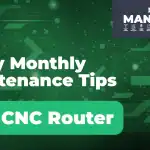Keep your fibre laser cutting cleanly and reliably with this quick, operator-friendly checklist. Pair these notes with the video for best results.
Before every use
1) Capacitance (height) calibration
Run the machine’s auto height calibration and confirm Z-axis values so your stand-off is stable, edge quality is consistent, and the head stays out of trouble on warped sheet.
2) Assist gas pressures
Verify regulators and gauges match your material/thickness recipes. Stable oxygen/nitrogen delivery prevents burrs, poor edges, and incomplete cuts.
3) Clean head, nozzle & protective lens
Remove spatter and film using optics-safe wipes/solvents only. A clean window and nozzle preserve beam quality and extend consumable life.
Daily checks
4) Operator environment
Keep touchscreens, keyboards and controllers clean and responsive; dust in ports and around E-stops can cause annoying input faults.
5) Leak inspection
Walk the cooling/oil lines, fittings and manifolds for moisture, stains or corrosion. Fix small leaks before they escalate to downtime.
Weekly checks
6) Beam/nozzle alignment
Run the built-in centring routine and adjust as needed (check each nozzle type you use). Proper alignment equals cleaner edges and less scrap.
7) Ceramic ring condition
Look for chips, burns, or looseness and replace promptly—this small part stabilises the nozzle and supports consistent beam delivery.
8) Slag tray housekeeping
Empty and wipe trays; heavy build-up restricts airflow and raises fire risk. Inspect for warping or residue.
9) Electrical cabinet dust-out
Power down, then vacuum/ESD-blow dust from boards, connectors and fans; clean or replace filters to keep electronics cool and stable.
Every 6 months
10) Chiller service & coolant refresh
Drain, flush and refill with manufacturer-approved coolant/deionised water (with inhibitor). Don’t mix types and always log the service.
Why it pays to be proactive
These short, repeatable checks protect cut quality, throughput and safety—while reducing unplanned stoppages that hit delivery and margins. Build them into your routine and track results in a simple maintenance log.
Quick troubleshooting cues
- Heavy burr/dross: recheck gas pressure/purity → inspect nozzle → review speed/focus.
- Rough edges/striations: verify focus height → confirm alignment → clean/replace protection window.
- Messy pierces: reduce pierce power/time and confirm nozzle centring and plate flatness.





